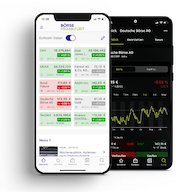Market sentiment: “Quick profits secured immediately”

The prices, which briefly rose above 24,000 points, encouraged profit-taking and, in some cases, short positions. Not a bad starting position for Goldberg.
Summary
In response to the price gains during the course of the year, of which little remains at the bottom line, 14 percent of professionals and 8 percent of private investors reacted by selling shares. Profit-taking, thinks Joachim Goldberg. Some went short directly, while the rest took a wait-and-see approach. The behavioral economist sees the end of the first half of the year as the trigger for the neutral positioning, which is relevant at least for the professionals. Both sentiment indices now stand at 0 and +8 points, respectively.
Goldberg expects that the new short positions could soon be covered again. In addition, quite a few investors were waiting on the sidelines for a favorable entry point. He expects purchases to start at 23,450 and 23,500 points. On balance, the sentiment situation for the DAX has improved compared to the previous week.
2 July 2025. FRANKFURT (Goldberg & Goldberg). Measured against the almost euphoric shift in sentiment in the middle of last week, trading on the domestic markets has remained fairly stable. Even though expectations were high in some quarters, the DAX remained slightly above the supply zone we had targeted the week before (24,050/100 DAX points). And because of the subsequent setback, the stock market barometer only gained 0.6 percent week-on-week.
Meanwhile, on the US stock markets, there was a feeling that a more bullish undertone prevailed in price movements, combined with small gains without any major setbacks. This is particularly true as the hopes of many players for the imminent interest rate cuts demanded by US President Donald Trump seem to be gradually solidifying. Secretly, some are already hoping for the next interest rate move on July 29, and there is greater belief than before that there will be more than two interest rate cuts this year.
Mill open, mill closed
Many of the institutional investors with a medium-term trading horizon whom we surveyed are likely to have become active sellers in the supply zone we mentioned at the beginning. This is because our Frankfurt Stock Exchange Sentiment Index has fallen by 20 points compared to the previous week and is now at zero. At the same time, the bull camp has shrunk by 13 percentage points, with the departures distributed almost evenly between neutral investors and the bear camp.
In other words, while slightly less than half of asset managers – possibly due to the end of the half-year – are content to take profits and have moved to the sidelines, the other half have turned their positions around 180° from long to short. This was probably also driven by the uncertain situation regarding Donald Trump's planned introduction of trade tariffs, which may be finalized on July 9. But first and foremost, the (repeated) accumulated profits and their realization are likely to have been at least as important.
We see a similar development among private investors. The Frankfurt Stock Exchange Sentiment Index in this panel also fell quite significantly by 14 points to a new level of +6. While investors surveyed via social media increased their bullish positions, the remaining private investors behaved very similarly to their institutional counterparts. Perhaps even a little more risk-averse, because the bottom line is that the bull camp among private investors has shrunk by 8 percentage points, with 75 percent of those willing to switch sides moving directly to the short side. At the same time, the gap between the two subgroups has widened significantly.
End of half-year as a new start
Many institutional investors are therefore starting the second half of the year with a neutral positioning, partly due to the balance sheet date, with the group of neutral players accounting for a fairly high 32 percent of all respondents. The recent short positions should not be overlooked, as they could soon be covered again if DAX prices fall again. In addition, there are investors who are currently still neutral but are likely waiting for a favorable entry opportunity. Incidentally, we expect most of the potential demand from both groups to be in the range between 23,450 and 23,500 DAX points.
Interestingly, international and long-term investors appear to have been less involved than before during the past two weeks. At least the recent DAX setback seems to have been home-grown due to new positioning in Germany. On balance, the sentiment situation for the DAX has improved compared to the previous week.
by Joachim Goldberg
2 July 2025, © Goldberg & Goldberg for boerse-frankfurt.de
Video Commentary (in German)
Sentiment index of institutional investors

| Bullish | Bearish | Neutral | |
| Total | 34% | 34% | 32% |
| vs. last survey | -13% | +7% | +6% |
DAX (change since last survey): 23,750 points (+130 points since last survey)
Frankfurt Stock Exchange Sentiment Index for institutional investors: +/- 0 points (-20 points since last survey)
Sentiment index of private investors

| Bullish | Bearish | Neutral | |
| Total | 43% | 37% | 20% |
| vs. last survey | -8% | +6% | +2% |
DAX (change since last survey): 23,750 points (+130 points since last survey)
Frankfurt Stock Exchange Sentiment Index for private investors: + points (-14% since last survey)
About the Frankfurt Stock Exchange Sentiment Index
The Frankfurt Stock Exchange Sentiment Index ranges between -100 (total pessimism) and +100 (total optimism), with the transition from positive to negative values marking the neutral line.
Weitere Artikel dieses Kolumnisten
| Uhrzeit | Titel |
|---|






